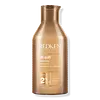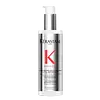What's inside
What's inside
 Key Ingredients
Key Ingredients

 Benefits
Benefits

 Concerns
Concerns

 Ingredients Side-by-side
Ingredients Side-by-side

Water
Skin ConditioningSodium Laureth Sulfate
CleansingSodium Chloride
MaskingCocamidopropyl Betaine
CleansingDimethicone
EmollientParfum
MaskingSodium Benzoate
MaskingAmodimethicone
Carbomer
Emulsion StabilisingGlycerin
HumectantGuar Hydroxypropyltrimonium Chloride
Skin ConditioningTrideceth-10
CleansingSalicylic Acid
MaskingHexylene Glycol
EmulsifyingGlycol Distearate
EmollientCitric Acid
BufferingMica
Cosmetic ColorantSodium Cocoyl Amino Acids
CleansingPEG-100 Stearate
Phenoxyethanol
PreservativeSteareth-6
EmulsifyingTrideceth-3
EmulsifyingPotassium Dimethicone PEG-7 Panthenyl Phosphate
Skin ConditioningCI 77891
Cosmetic ColorantSodium Sarcosinate
Benzyl Alcohol
PerfumingPropylene Glycol
HumectantCoumarin
PerfumingLinalool
PerfumingPEG-45m
HumectantBenzyl Benzoate
AntimicrobialHexyl Cinnamal
PerfumingLimonene
PerfumingAloe Barbadensis Leaf Juice Powder
Skin ConditioningArginine
MaskingHydrolyzed Soy Protein
HumectantPlukenetia Volubilis Seed Oil
EmollientCaramel
Cosmetic ColorantAcetic Acid
BufferingFumaric Acid
BufferingHydrolyzed Vegetable Protein Pg-Propyl Silanetriol
Skin ConditioningCereus Grandiflorus Flower Extract
Skin ConditioningGlucose
HumectantLactic Acid
BufferingPotassium Sorbate
PreservativeTetrasodium EDTA
BHT
AntioxidantTocopherol
AntioxidantSodium Hydroxide
BufferingWater, Sodium Laureth Sulfate, Sodium Chloride, Cocamidopropyl Betaine, Dimethicone, Parfum, Sodium Benzoate, Amodimethicone, Carbomer, Glycerin, Guar Hydroxypropyltrimonium Chloride, Trideceth-10, Salicylic Acid, Hexylene Glycol, Glycol Distearate, Citric Acid, Mica, Sodium Cocoyl Amino Acids, PEG-100 Stearate, Phenoxyethanol, Steareth-6, Trideceth-3, Potassium Dimethicone PEG-7 Panthenyl Phosphate, CI 77891, Sodium Sarcosinate, Benzyl Alcohol, Propylene Glycol, Coumarin, Linalool, PEG-45m, Benzyl Benzoate, Hexyl Cinnamal, Limonene, Aloe Barbadensis Leaf Juice Powder, Arginine, Hydrolyzed Soy Protein, Plukenetia Volubilis Seed Oil, Caramel, Acetic Acid, Fumaric Acid, Hydrolyzed Vegetable Protein Pg-Propyl Silanetriol, Cereus Grandiflorus Flower Extract, Glucose, Lactic Acid, Potassium Sorbate, Tetrasodium EDTA, BHT, Tocopherol, Sodium Hydroxide
Water
Skin ConditioningGlycerin
HumectantPropylene Glycol
HumectantGlycine
BufferingCitric Acid
BufferingSodium Hydroxide
BufferingParfum
MaskingCetrimonium Chloride
AntimicrobialPEG-40 Hydrogenated Castor Oil
EmulsifyingPolysorbate 20
EmulsifyingPolysorbate 80
EmulsifyingPhenoxyethanol
PreservativeHydrolyzed Vegetable Protein Pg-Propyl Silanetriol
Skin ConditioningQuaternium-80
Limonene
PerfumingHydroxypropyl Guar
Emulsion StabilisingHydroxypropyl Guar Hydroxypropyltrimonium Chloride
Linalool
PerfumingSodium Benzoate
MaskingCitral
PerfumingPotassium Sorbate
PreservativeWater, Glycerin, Propylene Glycol, Glycine, Citric Acid, Sodium Hydroxide, Parfum, Cetrimonium Chloride, PEG-40 Hydrogenated Castor Oil, Polysorbate 20, Polysorbate 80, Phenoxyethanol, Hydrolyzed Vegetable Protein Pg-Propyl Silanetriol, Quaternium-80, Limonene, Hydroxypropyl Guar, Hydroxypropyl Guar Hydroxypropyltrimonium Chloride, Linalool, Sodium Benzoate, Citral, Potassium Sorbate
 Reviews
Reviews

Ingredients Explained
These ingredients are found in both products.
Ingredients higher up in an ingredient list are typically present in a larger amount.
Citric Acid is an alpha hydroxy acid (AHA) naturally found in citrus fruits like oranges, lemons, and limes.
Like other AHAs, citric acid can exfoliate skin by breaking down the bonds that hold dead skin cells together. This helps reveal smoother and brighter skin underneath.
However, this exfoliating effect only happens at high concentrations (20%) which can be hard to find in cosmetic products.
Due to this, citric acid is usually included in small amounts as a pH adjuster. This helps keep products slightly more acidic and compatible with skin's natural pH.
In skincare formulas, citric acid can:
While it can provide some skin benefits, research shows lactic acid and glycolic acid are generally more effective and less irritating exfoliants.
Most citric acid used in skincare today is made by fermenting sugars (usually from molasses). This synthetic version is identical to the natural citrus form but easier to stabilize and use in formulations.
Read more about some other popular AHA's here:
Learn more about Citric AcidGlycerin is already naturally found in your skin. It helps moisturize and protect your skin.
A study from 2016 found glycerin to be more effective as a humectant than AHAs and hyaluronic acid.
As a humectant, it helps the skin stay hydrated by pulling moisture to your skin. The low molecular weight of glycerin allows it to pull moisture into the deeper layers of your skin.
Hydrated skin improves your skin barrier; Your skin barrier helps protect against irritants and bacteria.
Glycerin has also been found to have antimicrobial and antiviral properties. Due to these properties, glycerin is often used in wound and burn treatments.
In cosmetics, glycerin is usually derived from plants such as soybean or palm. However, it can also be sourced from animals, such as tallow or animal fat.
This ingredient is organic, colorless, odorless, and non-toxic.
Glycerin is the name for this ingredient in American English. British English uses Glycerol/Glycerine.
Learn more about GlycerinWe don't have a description for Hydrolyzed Vegetable Protein Pg-Propyl Silanetriol yet.
Limonene is a fragrance that adds scent and taste to a formulation.
It's found in the peel oil of citrus fruits and other plants such as lavender and eucalyptus. The scent of limonene is generally described as "sweet citrus".
Limonene acts as an antioxidant, meaning it helps neutralize free radicals.
When exposed to air, oxidized limonene may sensitize the skin. Because of this, limonene is often avoided by people with sensitive skin.
The term 'fragrance' is not regulated in many countries. In many cases, it is up to the brand to define this term. For instance, many brands choose to label themselves as "fragrance-free" because they are not using synthetic fragrances. However, their products may still contain ingredients such as essential oils that are considered a fragrance.
Learn more about LimoneneLinalool is a fragrance and helps add scent to products. It's derived from common plants such as cinnamon, mint, citrus, and lavender.
Like Limonene, this ingredient oxidizes when exposed to air. Oxidized linalool can cause allergies and skin sensitivity.
This ingredient has a scent that is floral, spicy tropical, and citrus-like.
Learn more about LinaloolParfum is a catch-all term for an ingredient or more that is used to give a scent to products.
Also called "fragrance", this ingredient can be a blend of hundreds of chemicals or plant oils. This means every product with "fragrance" or "parfum" in the ingredients list is a different mixture.
For instance, Habanolide is a proprietary trade name for a specific aroma chemical. When used as a fragrance ingredient in cosmetics, most aroma chemicals fall under the broad labeling category of “FRAGRANCE” or “PARFUM” according to EU and US regulations.
The term 'parfum' or 'fragrance' is not regulated in many countries. In many cases, it is up to the brand to define this term.
For instance, many brands choose to label themselves as "fragrance-free" because they are not using synthetic fragrances. However, their products may still contain ingredients such as essential oils that are considered a fragrance by INCI standards.
One example is Calendula flower extract. Calendula is an essential oil that still imparts a scent or 'fragrance'.
Depending on the blend, the ingredients in the mixture can cause allergies and sensitivities on the skin. Some ingredients that are known EU allergens include linalool and citronellol.
Parfum can also be used to mask or cover an unpleasant scent.
The bottom line is: not all fragrances/parfum/ingredients are created equally. If you are worried about fragrances, we recommend taking a closer look at an ingredient. And of course, we always recommend speaking with a professional.
Learn more about ParfumPhenoxyethanol is a preservative that has germicide, antimicrobial, and aromatic properties. Studies show that phenoxyethanol can prevent microbial growth. By itself, it has a scent that is similar to that of a rose.
It's often used in formulations along with Caprylyl Glycol to preserve the shelf life of products.
Potassium Sorbate is a preservative used to prevent yeast and mold in products. It is commonly found in both cosmetic and food products.
This ingredient comes from potassium salt derived from sorbic acid. Sorbic acid is a natural antibiotic and effective against fungus.
Both potassium sorbate and sorbic acid can be found in baked goods, cheeses, dried meats, dried fruit, ice cream, pickles, wine, yogurt, and more.
You'll often find this ingredient used with other preservatives.
Learn more about Potassium SorbatePropylene Glycol is an odorless, colorless liquid. As a humectant, it helps skin retain moisture. It also aids in delivering active ingredients.
Another role of this ingredient is preventing a product from melting or freezing. Propylene glycol also adds antimicrobrial properties to a product, elongating product lifespan.
This ingredient is considered an organic alcohol and commonly added into both cosmetics and foods.
Those with sensitive skin or conditions may develop a rash when using this ingredient.
Learn more about Propylene GlycolSodium Benzoate is a preservative. It's used in both cosmetic and food products to inhibit the growth of mold and bacteria. It is typically produced synthetically.
Both the US FDA and EU Health Committee have approved the use of sodium benzoate. In the US, levels of 0.1% (of the total product) are allowed.
Sodium benzoate works as a preservative by inhibiting the growth of bacteria inside of cells. It prevents the cell from fermenting a type of sugar using an enzyme called phosphofructokinase.
It is the salt of benzoic acid. Foods containing sodium benzoate include soda, salad dressings, condiments, fruit juices, wines, and snack foods.
Studies for using ascorbic acid and sodium benzoate in cosmetics are lacking, especially in skincare routines with multiple steps.
We always recommend speaking with a professional, such as a dermatologist, if you have any concerns.
Learn more about Sodium BenzoateSodium Hydroxide is also known as lye or caustic soda. It is used to adjust the pH of products; many ingredients require a specific pH to be effective.
In small amounts, sodium hydroxide is considered safe to use. However, large amounts may cause chemical burns due to its high alkaline.
Your skin has a natural pH and acid mantle. This acid mantle helps prevent harmful bacteria from breaking through. The acid mantle also helps keep your skin hydrated.
"Alkaline" refers to a high pH level. A low pH level would be considered acidic.
Learn more about Sodium HydroxideWater. It's the most common cosmetic ingredient of all. You'll usually see it at the top of ingredient lists, meaning that it makes up the largest part of the product.
So why is it so popular? Water most often acts as a solvent - this means that it helps dissolve other ingredients into the formulation.
You'll also recognize water as that liquid we all need to stay alive. If you see this, drink a glass of water. Stay hydrated!
Learn more about Water